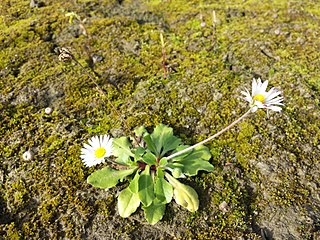
Bellis perennis, the daisy, is a European species of the family Asteraceae, often considered the archetypal species of the name daisy. To distinguish this species from other plants known as daisies, it is sometimes qualified or known as common daisy, lawn daisy or English daisy.

Claytonia virginica, the Virginia springbeauty, eastern spring beauty, grass-flowernarrowleaf springbeauty or fairy spud, is an herbaceous perennial plant in the family Montiaceae. Its native range is eastern North America. Its scientific name honors Colonial Virginian botanist John Clayton (1694–1773).

Rudbeckia laciniata, the cutleaf coneflower, is a species of flowering plant in the family Asteraceae. It is native to North America, where it is widespread in both Canada and the United States. Its natural habitat is wet sites in flood plains, along stream banks, and in moist forests. Common names other than cutleaf coneflower include cutleaf, goldenglow, green-headed coneflower, tall coneflower, sochan and thimbleweed.

Anemonastrum canadense, synonym Anemone canadensis, the Canada anemone, round-headed anemone, round-leaf thimbleweed, meadow anemone, windflower, or crowfoot, is a herbaceous perennial flowering plant in the family Ranunculaceae. It is native to moist meadows, thickets, streambanks, and lakeshores in North America, spreading rapidly by underground rhizomes. It is valued for its white flowers.

Astragalus bisulcatus, commonly called two-grooved milkvetch or silver-leafed milkvetch, is a leafy perennial with pea-like flowers. It is native to central and western North America, and typically grows on selenium-rich soils. It accumulates selenium within its tissues, and when livestock consume it, the selenium can be toxic.
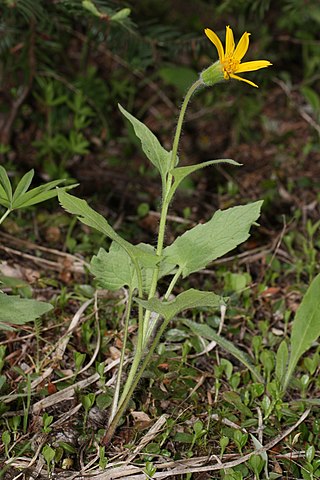
Arnica cordifolia is a species of arnica in the sunflower family, known by the common name heartleaf arnica. It is native to western North America.
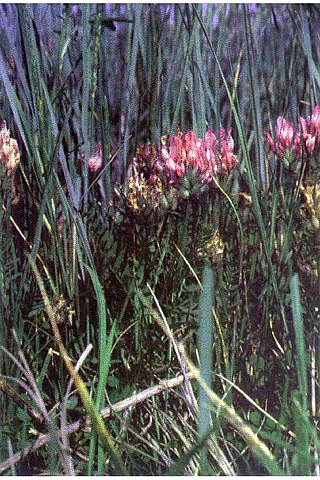
Astragalus agrestis is a species of milkvetch known by the common names purple milkvetch, purple loco, and field milkvetch. It is native to much of western and northern North America from most of Canada to the southwestern United States, as well as eastern Asia. It grows in vernally moist areas such as meadows, and is often found in sagebrush.

Astragalus casei is a species of milkvetch known by the common name Case's milkvetch. It is native to the Mojave Desert and its sky island woodlands of eastern California and western Nevada.

Gaillardia pinnatifida, the Hopi blanketflower or red dome blanketflower, is a perennial plant in the family Asteraceae found in northern Mexico and in the south-central and southwestern United States.
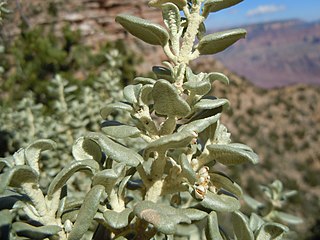
Shepherdia rotundifolia, the roundleaf buffaloberry or silverleaf, is a 3-to-6-foot (1-to-2-meter) evergreen shrub in the oleaster family (Elaeagnaceae) that grows only in the Colorado Plateau (endemic) of the southwestern United States. The common name comes from western settlers using the cooked berries in a sauce for eating cooked buffalo meat.

Asclepias involucrata, synonym Asclepias macrosperma, is a perennial plant in the family Apocynaceae native from the west and south central United States to north Mexico. In the southwestern United States, it is found in the Colorado Plateau and Canyonlands region.

Lupinus pusillus, the rusty lupine or dwarf lupine, is an annual plant in the legume family (fabaceae) found in the Colorado Plateau and Canyonlands region of the southwestern United States(California), and north to Montana.
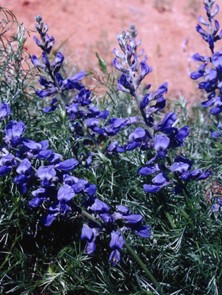
Sophora stenophylla, the fringeleaf necklacepod, or silvery sophora, is a perennial plant in the legume family (Fabaceae) found in the Colorado Plateau and Canyonlands region of the southwestern United States.

Penstemon comarrhenus is a perennial plant in the plantain family (Plantaginaceae) found in the Colorado Plateau and Canyonlands region of the southwestern United States.

Penstemon cyanocaulis, the bluestem penstemon or bluestem beardtongue, is a perennial plant in the plantain family (Plantaginaceae) found in the Colorado Plateau and Canyonlands region of the southwestern United States.
Aliciella subnuda is a biennial or perennial plant in the phlox family (Polemoniaceae) found in the Colorado Plateau and Canyonlands region of the southwestern United States.
Primula specuicola is perennial plant in the primrose family (Primulaceae) found in the Colorado Plateau and Canyonlands region of the southwestern United States.

Astragalus preussii is an annual or perennial plant in the legume family (Fabaceae) found in the Colorado Plateau and Canyonlands region of the southwestern United States.

Astragalus mollissimus is a perennial plant in the legume family (Fabaceae) found in the Colorado Plateau and Canyonlands region of the southwestern United States.

Astragalus desperatus is a perennial plant in the legume family (Fabaceae) found in the Colorado Plateau and Canyonlands region of the southwestern United States.


















